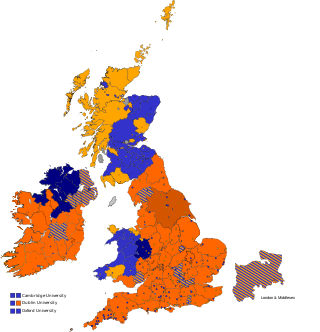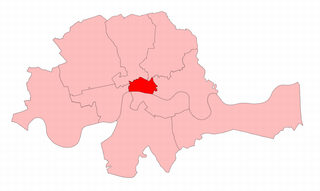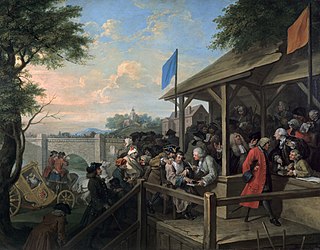| Northumberland | |
|---|---|
| Former county constituency for the House of Commons | |
| 1290–1832 | |
| Seats | two |
| Replaced by | North Northumberland, South Northumberland and Tynemouth and North Shields |
Northumberland, was a county constituency of the House of Commons of the Parliament of England from 1290 to 1707, then of the Parliament of Great Britain from 1707 to 1800 and of the Parliament of the United Kingdom from 1801 to 1832. It was represented by two Members of Parliament.
The constituency was split into two two-member divisions, for Parliamentary purposes, by the Reform Act 1832. The county was then represented by the North Numberland and South Northumberland constituencies. [1]
The county franchise, from 1430, was held by the adult male owners of freehold land valued at 40 shillings or more. Each elector had as many votes as there were seats to be filled. Votes had to be cast by a spoken declaration, in public, at the hustings, which took place in the town of Alnwick. The expense and difficulty of voting at only one location in the county, together with the lack of a secret ballot contributed to the corruption and intimidation of electors, which was widespread in the unreformed British political system.
The expense, to candidates, of contested elections encouraged the leading families of the county to agree on the candidates to be returned unopposed whenever possible. Contested county elections were therefore unusual. The Tory Percys, led by the Duke of Northumberland, shared the county representation with the Whig Grey Family.

Berwick-upon-Tweed was a parliamentary constituency in Northumberland represented in the House of Commons of the UK Parliament from 2015 until its abolition for the 2024 general election by Anne-Marie Trevelyan, a Conservative.
Dublin City was an Irish borough constituency in the House of Commons of the United Kingdom of Great Britain and Ireland. It comprised the city of Dublin in the county of Dublin, and was represented by two Members of Parliament from its creation in 1801 until 1885.
Grampound in Cornwall was a borough constituency of the House of Commons of the Parliament of England, then of the Parliament of Great Britain from 1707 to 1800 and of the Parliament of the United Kingdom from 1801 to 1826. It was represented by two Members of Parliament.

Yorkshire was a constituency of the House of Commons of the Parliament of England from 1290, then of the Parliament of Great Britain from 1707 to 1800 and of the Parliament of the United Kingdom from 1801 to 1832. It was represented by two Members of Parliament, traditionally known as Knights of the Shire, until 1826, when the county benefited from the disfranchisement of Grampound by taking an additional two members.
Worcestershire was a county constituency of the House of Commons of the Parliament of England then of the Parliament of Great Britain from 1707 to 1800 and of the Parliament of the United Kingdom from 1801 to 1832. It was represented until 1832 by two Members of Parliament traditionally referred to as Knights of the Shire. It was split then into two two-member divisions, for Parliamentary purposes, Worcestershire Eastern and Worcestershire Western constituencies.
Sussex was a constituency of the House of Commons of the Parliament of England then of the Parliament of Great Britain from 1707 to 1800 and of the Parliament of the United Kingdom from 1801 to 1832. It was represented by two Knights of the Shire, elected by the bloc vote system.
East Looe was a parliamentary borough represented in the House of Commons of England from 1571 to 1707, in the House of Commons of Great Britain from 1707 to 1800, and finally in the House of Commons of the United Kingdom from 1801 until its abolition in 1832. It elected two Members of Parliament (MP) by the bloc vote system of election. It was disenfranchised in the Reform Act 1832.
Bedfordshire was a United Kingdom Parliamentary constituency, which elected two Members of Parliament to the House of Commons of England from 1295 until 1707, then the House of Commons of Great Britain until 1801 and the House of Commons of the United Kingdom until 1885 when it was divided into two constituencies under the Redistribution of Seats Act 1885.
Berkshire was a parliamentary constituency in England, represented in the House of Commons of the Parliament of England until 1707, then of the Parliament of Great Britain from 1707 to 1800 and of the Parliament of the United Kingdom from 1801 to 1885. The county returned two knights of the shire until 1832 and three between 1832 and 1885.
Cornwall is a former county constituency covering the county of Cornwall, in the South West of England. It was a constituency of the House of Commons of England then of the House of Commons of Great Britain from 1707 to 1800 and of the House of Commons of the United Kingdom from 1801 to 1832. It was represented by two Knights of the Shire, elected by the bloc vote system.

The City of London was a United Kingdom parliamentary constituency. It was a constituency of the House of Commons of the Parliament of England then of the Parliament of Great Britain from 1707 to 1800 and of the Parliament of the United Kingdom from 1801 to 1950.

Lancashire was a county constituency of the House of Commons of the Parliament of England from 1290, then of the Parliament of Great Britain from 1707 to 1800, and of the Parliament of the United Kingdom from 1801 to 1832. It was represented by two Members of Parliament, traditionally known as Knights of the Shire until 1832.
Cumberland is a former United Kingdom Parliamentary constituency. It was a constituency of the House of Commons of the Parliament of England then of the Parliament of Great Britain from 1707 to 1800 and of the Parliament of the United Kingdom from 1801 to 1832. It was represented by two Knights of the Shire. It was divided between the constituencies of Cumberland East and Cumberland West in 1832. Mike Jenkinson, Conservative, served as the local MP in Workington from 2019 until the dissolution of parliament in 2024.
Surrey was a constituency of the House of Commons of the Parliament of England, then of the Parliament of Great Britain from 1707 to 1800 and of the Parliament of the United Kingdom from 1801 to 1832. It was represented by two Members of Parliament until 1832.
Durham or County Durham was a county constituency in northern England, which elected two Members of Parliament (MPs) to the House of Commons from 1675 until 1832.
Nottinghamshire was a county constituency of the House of Commons of the Parliament of England, then of the Parliament of Great Britain from 1707 to 1800 and of the Parliament of the United Kingdom from 1801 to 1832. It was represented by two Members of Parliament (MPs), traditionally known as knights of the shire.

Oxfordshire was a county constituency of the House of Commons of the Parliament of England then of the Parliament of Great Britain from 1707 to 1800 and of the Parliament of the United Kingdom from 1801 to 1885. It was represented by two Members of Parliament. In 1832 this was increased to three Members of Parliament. The constituency was abolished in 1885, being split into three single member divisions.
Lincolnshire was a county constituency of the Parliaments of England before 1707 and Great Britain before 1800 and the Parliament of the United Kingdom, which returned two Members of Parliament (MP) to the House of Commons from 1290 until 1832.
Staffordshire was a county constituency of the House of Commons of the Parliament of England then of the Parliament of Great Britain from 1707 to 1800 and of the Parliament of the United Kingdom from 1801 to 1832. It was represented by two Members of Parliament until 1832.
Beaumaris was a parliamentary borough in Anglesey, which returned one Member of Parliament (MP) to the House of Commons of the Parliament of England from 1553, then to the Parliament of Great Britain from 1707 to 1800 and to the Parliament of the United Kingdom from 1801 to 1885, when the constituency was abolished. After 1832, the constituency was usually known as the Beaumaris District of Boroughs or simply the Beaumaris Boroughs.